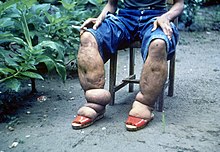| Lymphatic filariasis | |
|---|---|
| Other names | Elephantiasis tropica,[1] elephantiasis arabum[1] |
 | |
| Elephantiasis of the legs due to filariasis. | |
| Specialty | Infectious diseases |
| Symptoms | None, severe swelling of the arms, legs, breasts, or genitals[2] |
| Causes | Filarial worms spread by mosquitos[3] |
| Diagnostic method | Microscopic examination of blood[4] |
| Prevention | Bed nets, mass deworming[2] |
| Medication | Albendazole with ivermectin or diethylcarbamazine[2] |
| Frequency | 40 million (2022)[5] |
Lymphatic filariasis is a human disease caused by parasitic worms known as filarial worms.[2][3] Usually acquired in childhood, it is a leading cause of permanent disability worldwide, impacting over a hundred million people and manifesting itself in a variety of severe clinical pathologies[6][7] While most cases have no symptoms, some people develop a syndrome called elephantiasis, which is marked by severe swelling in the arms, legs, breasts, or genitals. The skin may become thicker as well, and the condition may become painful.[2] Affected people are often unable to work and are often shunned or rejected by others because of their disfigurement and disability.[7]
It is the first of the mosquito-borne diseases to have been identified.[8] The worms are spread by the bites of infected mosquitoes.[2] Three types of worms are known to cause the disease: Wuchereria bancrofti, Brugia malayi, and Brugia timori, with Wuchereria bancrofti being the most common.[2] These worms damage the lymphatic system by nesting within the lymphatic vessels and disrupting the system's normal function. Worms can survive within the human body for up to 8 years, all while reproducing millions of larvae which circulate through the blood.[9] The disease is diagnosed by microscopic examination of blood collected during the night. The blood is typically examined as a smear after being stained with Giemsa stain. Testing the blood for antibodies against the disease may also permit diagnosis.[4] Other roundworms from the same family are responsible for river blindness.[10]
Prevention can be achieved by treating entire groups affected by the disease, known as mass deworming.[2] This is done every year for about six years, in an effort to rid a population of the disease entirely.[2] Medications usually include a combination of two or more anthelmintic agents: albendazole, ivermectin, and diethylcarbamazine.[11] Efforts to prevent mosquito bites are also recommended, including reducing the number of mosquitoes and promoting the use of bed nets.[2]
As of 2022, about 40 million people were infected, and about 863 million people were at risk of the disease in 47 countries.[5] It is most common in tropical Africa and Asia.[2] Lymphatic filariasis is classified as a neglected tropical disease and one of the four main worm infections.[10] The impact of the disease results in economic losses of billions of US dollars a year.[2]
- ^ a b James WD, Berger T, Elston D (2015). Andrews' Diseases of the Skin: Clinical Dermatology. Elsevier Health Sciences. p. 432. ISBN 9780323319690. Archived from the original on 12 October 2016.
- ^ a b c d e f g h i j k l "Lymphatic filariasis Fact sheet N°102". World Health Organization. March 2014. Archived from the original on 25 March 2014. Retrieved 20 March 2014.
- ^ a b "Lymphatic filariasis". World Health Organization. Retrieved 7 May 2016.
- ^ a b "Parasites – Lymphatic Filariasis Diagnosis". CDC. 14 June 2013. Archived from the original on 22 February 2014. Retrieved 21 March 2014.
- ^ a b "Lymphatic filariasis". www.who.int. Retrieved 4 October 2019.
- ^ Chakraborty, Sanjukta; Gurusamy, Manokaran; Zawieja, David C.; Muthuchamy, Mariappan (July 2013). "Lymphatic filariasis: Perspectives on lymphatic remodeling and contractile dysfunction in filarial disease pathogenesis". Microcirculation. 20 (5): 349–364. doi:10.1111/micc.12031. ISSN 1073-9688. PMC 3613430. PMID 23237232.
- ^ a b Centers for Disease Control and Prevention (22 October 2018). "Lymphatic Filariasis". Parasites. Retrieved 10 December 2022.
- ^ "Lymphatic filariasis". Health Topics A to Z. World Health Organization. Retrieved 25 September 2011.
- ^ "Lymphatic filariasis". www.who.int. Retrieved 17 November 2023.
- ^ a b "Working to overcome the global impact of neglected tropical diseases – Summary" (PDF). Relevé Épidémiologique Hebdomadaire. 86 (13): 113–20. March 2011. PMID 21438440.
- ^ "Global programme to eliminate lymphatic filariasis: progress report, 2022". www.who.int. Retrieved 20 November 2023.